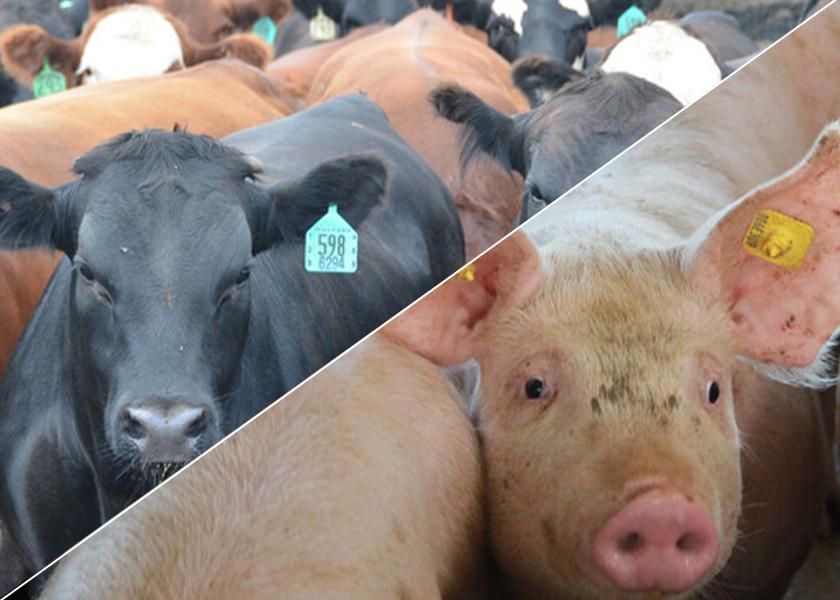Livestock Analysis | July 1, 2022

Price action: July lean hog futures rose 47.5 cents to $109.60. August lean hogs rose 87.5 cents to $102.975, down $3.80 for the week.
5-day outlook: Hog market bulls ended the week on a firm note behind short covering after August futures dropped four consecutive sessions. Futures remain in a two-week downtrend amid ideas cash fundamentals have peaked, which may produce more selling pressure next week. The next CME lean hog index is expected at $110.70, down 14 cents from today’s figure and the third straight decline. Further declines would likely signal the start of a down cycle in the cash market with slaughter levels are expected to rise through the second half of the year. The national direct five-day rolling average cash hog price today was quoted at $116.32. Pork cutout values rose $1.01 early today to $108.26 on strong midday movement of 181 loads.
30-day outlook: The nearly $8 discount August futures hold to the CME cash index suggests the cash market has put in a seasonal top. That price gap will have to narrow significantly in the near term to begin to suggest a turnaround in cash hogs and futures. As U.S. recession worries grow, the pork industry will keep a close eye on consumer demand. While a recession could drive consumers to cheaper protein sources, the higher beef prices at the meat counter may see pork being the next-best alternative if consumers stay home to dine more often, to save money.
90-day outlook: USDA on Thursday reported weekly U.S. pork sales of 32,300 MT for 2022, up 27% from the previous week. The U.S. pork export pace will have to improve in the coming months to keep a floor under cash hog and futures prices. The U.S. dollar index this week posted solid gains and is back near its recent 20-year high, which could be bearish for dollar-denominated commodities.
What to do: Be prepared to extend feed coverage on a pullback to the recent lows.
Hedgers: Carry all risk in the cash market for now.
Feed needs: You are hand-to-mouth on corn-for-feed and soybean meal needs.
Price action: August live cattle surged $2.025 to $134.60, the highest closing price since June 22 and up $1.225 for the week. August feeder futures fell 90 cents to $174.50, up $2.00 on the week.
5-day outlook: This week’s late advance reflected sustained strength in cash cattle, which climbed to the highest levels since 2015. The Monday-Thursday average for the five direct-market areas climbed to $146.10, up $1.55 from last week’s average and a reflection of tight market-ready supplies, increased feedlot leverage with packers and diminished beef production per head, especially with demand throughout the marketing system going into the summer doldrums. Choice cutout values fell 47 cents early today to $263.53 and may remain under pressure next week. Thus, fundamentals don’t seem terribly supportive. But today’s surge pushed August futures above the contract’s 40-day moving average, suggesting potential for an upside follow-though.
30-day outlook: July could be an interesting month for the cattle industry, with high prices contrasted with some of the weakest demand levels of the year and current feedlot marketings. We are cautiously optimistic, thinking the nearby supply tightness seen this week will persist, especially if it remains hot and dry over the Great Plains. Ongoing recession fears could limit futures upside, especially if U.S. stocks continue languishing, but red meat demand has historically held up well during recessions.
90-day outlook: Sustained current feedlot marketing could be the key to the summer-fall outlook, since, as recent price action has shown, it can “cover a lot of sins” by the feedlot industry. But a recession and reduced demand could weigh on prices, especially if grocers maintain retail beef at greatly elevated levels. We’re less concerned about the fall-winter-spring outlook, due to the removal of sizeable premiums previously maintained by the fourth-quarter contracts. October live cattle are around $140 and December is about $146, essentially at par to current cash prices in the western Plains. This diminishes producer incentives to place cattle aggressively in the months ahead, but, more importantly, also reduces the temptation to hold cattle in feedlot longer than absolutely necessary.
What to do: Be prepared to extend feed coverage on a pullback to the recent lows.
Hedgers: Carry all risk in the cash market for now.
Feed needs: You are hand-to-mouth on corn-for-feed and soybean meal needs.






